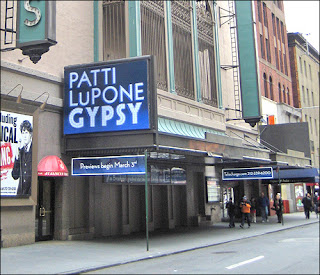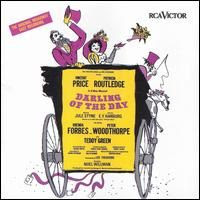SarahB gave me a little iota of hell (teensy) for leaving out Prettybelle in my last post. I apologize to those diehard fans by placing that show at the top of tonight’s list…which will include two selections from said score.
“You Never Looked Better”/”When I’m Drunk, I’m Beautiful” – Prettybelle (Jule Styne-Bob Merrill; 1971; closed in Boston) A schizophrenic southern belle with a drinking problem, an now-deceased abusive husband and a penchant for whoring herself out to minorities. And would you believe, Jerry Herman didn’t write it! The show was problematic from the beginning, namely the the source material. “You Never Looked Better” was actually cut while the show was out of town; but when they recorded the album (some ten years later) they reinstated this gem Angela Lansbury sings after her husband dies. There’s a chance it’ll be sung at my funeral. However, the most glorious moment of the show is the eleven o’clock number “When I’m Drunk, I’m Beautiful.” The title says it all, but you need to hear the lead-in, the clever lyrics and the glorious bridge (which is actually quite Hermanesque). A no-holds barred paean to the magic of alcohol, Lansbury sends this one out of the ballpark; a cultist’s delight.
“So Much You Loved Me” – Rex (Richard Rodgers-Sheldon Harnick; 1976; Lunt-Fontanne – 48 performances). You’d think Henry VIII would make for great singing; but, alas it didn’t. The score is decent, especially whenever Penny Fuller opens her mouth. This ballad, sung by Anne Boleyn to Henry at the end of their relationship, has marvelous lyrics and a gorgeous melodic progression in the A-section from Mr. Rodgers. A gem of a song. (Sarah Brightman recorded this song, the only one from the score to have life outside of it. But, c’mon, who the hell wants to hear that?) (The melody is also used in “From Afar”: Henry’s soliloquized, yet secretive admiration for his daughter Elizabeth).
“Why Do the Wrong People Travel?” – Sail Away (Noel Coward; Broadhurst – 167 performances). Truth be told, I actually judge this from the original London cast recording of the score, which I really prefer to the Broadway album. Most specifically because it doesn’t censor the funniest joke in this song. Elaine Stritch starred as a “world-weary” cruise hostess finding romance onboard ship in a role written specifically for her by Noel Coward. Well, this was originally going to be an operetta with Stritch as the comic support; but, out of town the show was overhauled with the original leads fired, their parts cut out entirely and Stritch made the star (she would be above-the-title in London). The show was dismissed as decidedly old-fashioned by critics and had relatively brief runs in NY and London (where it played 262 performances, after an even worse critical reception). The song is a sardonic showcase in the eleven o’clock spot for Stritchie (hmm, “The Ladies Who Lunch” anyone?) in which she lists her grievances about the tourists she encounters. It’s pretty riotous and Stritch (naturally) still brought down the house when she reprised it in At Liberty.
“Somehow I Never Could Believe” – Street Scene (Kurt Weill-Langston Hughes; 1947; Adelphi – 148 performances). Elmer Rice‘s tragedy became the basis for this ambitious “American opera” with some glorious results. Combining legitimate opera with musical comedy (more of the former than the latter), there are a great many aural wonders (“Ain’t it Awful the Heat,” “Lonely House,” “Moon-Faced, Starry-Eyed”), but it is this daring seven minute aria that captivated me on the first listen. Weill and Hughes took the traditional character am/want song and used it to tell us the history of the character of ill-fated Anna Maurrant. She sings of her hopes and dreams of her childhood and of how she watched those dreams die trapped in a loveless marriage in the tenements of NYC; a display of her loneliness and eventual optimism that things will be better. The song requires a dramatic soprano – basically something only the truly proficient in opera should attempt. A powerhouse of a showstopper. It would be nice if City Opera could get Victoria Clark for the role of Anna. Perhaps keep it in the Lincoln Center family and cast Kelli O’Hara and Aaron Lazar in the roles of the young lovers.
“All the Things You Are” – Very Warm for May (Jerome Kern-Oscar Hammerstein II; 1939; Alvin – 59 performances). The most beautiful song ever written. Well, if not, it’s certainly one of them. If you get the chance, you should hear the original orchestration for this number for a baritone and coloratura. Spellbinding is the word. There is a recording of the original cast from a radio broadcast, as well as a recreation on John McGlinn’s Broadway Showstoppers CD with Rebecca Luker.
“Children of the Wind,”/”Blame it on the Summer Night”/”Rags” – Rags (Charles Strouse-Stephen Schwartz; 1986; Mark Hellinger – 4 performances). Teresa Stratas was Rebecca, the heroine in this musical about a Jewish immigrant discovering injustice and fighting political corruption on the lower East Side of Manhattan. Consider it a sort of ‘post-Fiddler’ attempt at the immigrant experience in America. The show had little advance and poor notices and folded quickly. But it has a stunner of a score. The first song is a powerhouse aria in which Rebecca dreams of a home for herself and her son. The second is a delicious bluesy number with a scintillating orchestration and a seductive lyric in which Rebecca realizes she’s falling in love. The third is an angry indictment of the social stratifications of the time delivered by the ill-fated Bella, played by Judy Kuhn (who received a Tony nomination). The original cast album, recorded in 1991, features Julia Migenes in the place of Stratas.


